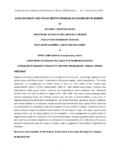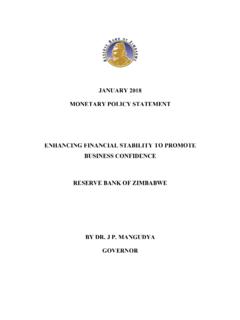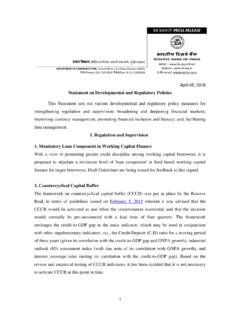Transcription of FINANCIAL STABILITY REPORT - SAMA
1 FINANCIAL STABILITY REPORT 2016. FINANCIAL STABILITY REPORT 2016. Saudi Arabian monetary Agency monetary Policy and FINANCIAL STABILITY Department King Saud Bin Abdulaziz Street Box 2992. Riyadh 11169. Kingdom of Saudi Arabia Telephone: 0114662218. Fax: 0114662966. Email: Contents Executive Summary .. 1. 1. The Global Economy: Trends, Risks and Growth Outlook .. 3. Recent Trends .. 3. Global FINANCIAL Developments and FINANCIAL STABILITY Risks .. 5. Global Growth Outlook .. 6. 2. The Saudi Economy: Trends, Risks and Growth Outlook .. 8. Growth and Inflation Trends .. 8. monetary Developments .. 8. monetary Aggregates .. 8. Reserve Assets .. 9. Fixed Exchange Rate Policy .. 10. Interest 10. Fiscal Developments .. 10. Labor Market Performance .. 12. External Sector Performance .. 12. Saudi Economy Growth Outlook and Risks .. 13. 3. Banking Sector: Operating Efficiency, Risks and Resilience.
2 15. Overview .. 15. Balance Sheet Assessment - Banks Assets .. 15. Bank Credit .. 18. Corporate Lending .. 19. Consumer Lending .. 19. Real Estate Lending .. 20. Maturity Distribution of Bank Credit .. 21. Balance sheet assessment Banks Liabilities .. 21. Bank Deposits .. 22. Maturity Distribution of Banks 22. Off-Balance Sheet Operations .. 22. Foreign Currency Exposure .. 23. Banking Sector Resilience .. 24. Profitability .. 24. Regulatory Capital and Asset Quality .. 24. Liquidity .. 25. Leverage .. 25. Risk Outlook of Banking Sector .. 25. 4. Non-Bank Credit: Recent Trends and Initiatives .. 31. Overview .. 31. Performance of SCIs .. 31. SCI Assets .. 31. Credit Extended by the SCIs .. 31. Non-Bank Finance Sector .. 33. Finance Company Assets .. 33. Finance Company Credit Extended .. 33. Finance companies Resilience .. 33. Profitability .. 33. Leverage.
3 34. Risk Outlook of Finance Companies .. 34. Overview of Policy Measures .. 34. 5. Insurance Sector: Performance, Coverage and Resilience .. 37. Overview .. 37. Performance .. 39. Resilience .. 40. 6. Capital Market STABILITY .. 46. Overview .. 46. Capital Market Activities .. 46. Market Legislation .. 47. Government Energy Policy Reform .. 47. Market Volatility and Risk .. 47. Market Liquidity .. 48. Shadow Banking .. 48. Market Resilience .. 48. Corporate Profitability .. 48. Corporate Leverage .. 49. Authorized Persons .. 50. Capital Adequacy .. 50. Profitability .. 50. Liquidity .. 51. Operational Risks of the Saudi Capital Market .. 51. 7. Payment System: Recent Initiatives .. 52. 52. MADA .. 52. SADAD Payment System: .. 53. Mobile Banking .. 54. Executive Summary Executive Summary A slower global economic growth continues to growth during 2015 was percent.
4 As for resilience, the pose risks to most countries including the kingdom of sector continued to be highly capitalized with total Saudi Arabia. According to the IMF, global economic regulatory and Tier 1 regulatory capital adequacy ratios growth slowed in 2015, with real GDP up by percent, recording percent and percent, respectively. versus a percent growth in the previous year. The Return on Assets (ROA) and Return on Equity (ROE). slowdown was due almost exclusively to slower growth in stood at percent and percent, respectively. The the world's developing and emerging nations. This pattern quality of assets remained high as banks continued to is not unprecedented; ever since the global economy maintain very low levels of non-performing loan ratios. started to recover post 2008 FINANCIAL crisis, real growth in Stress test results show that banks are able to withstand the developing/emerging world has been in a declining severe macroeconomic shocks including oil shocks.
5 Trajectory, from percent in 2010 down to an estimated Moreover, profitability continued to grow despite the low percent in 2015. Growth in the world's advanced level of interest rates while the sector's leverage ratio is economies remained relatively steady, at a slow but way above the 3 percent Basel requirement. sustainable pace, expanding by percent. Both external exposure risks and liquidity risks Global FINANCIAL markets are reflecting a higher continued to be limited. While the share of foreign assets degree of uncertainty. Doubts regarding the durability of increased in 2015 to reach percent, this percentage is the economic expansion are beginning to emerge in still relatively small as Saudi banks continued to rely on developed markets as well as regional markets. Certain domestic market. Liquidity risks are also limited. All economies, particularly in South America, are showing banks liquidity ratios including both the ratio of liquid increased stress.
6 The sharp price decline in commodity assets to total assets and to short-term liabilities and Basel markets as well as the expectation of a slowdown in china III liquidity ratios show ample liquidity. and divergent monetary policies (between the US and The non-banking finance sector continues to other major developed nations) have contributed to global support economic growth by providing another FINANCIAL markets instability. Moreover, deflation risks in channel of credit to the private sector. Both Specialized major developed and increased liquidity risks in some Credit Institutions (SCIs) and finance companies have developing countries may also pose some FINANCIAL enjoyed higher level of credit extended to the public. This STABILITY challenges. have helped reduce risks on the economy by diversifying The outlook for global economic growth is channels of credit and supplementing banks' lending.
7 The subdued, at best. While European growth is expected to Saudi Arabian monetary Agency (SAMA) has introduced continue to pick up, the US expansion has stalled early in policy adjustments on finance companies rules and 2016, and growth for the year is now projected at only regulations that would ease their operations and help percent, the lowest since 2009. In the developing world, increase their market share while making sure that recessions in Latin America, Russia, and Ukraine are FINANCIAL institutions follow prudent practices. offsetting the relatively good economic performance in The resilience of the insurance sector has Southeast Asia, keeping the outlook for growth in the improved but structural differences within the sector developing world somewhat subdued. persists. Overall, the profitability, solvency, and In Saudi Arabia, macroeconomic indicators efficiency increased as reflected by the various reflected a slowdown in 2015 as the oil prices continued profitability indicators, solvency margins, and loss ratios.
8 Its decline. This is an expected consequence in oil However, performance has widely diverged between dependent economies where government spending is the insurance companies where the performance of the top main impetus of the economic activities. As oil revenues three companies has outweighed the rest of companies in deteriorated, government relied on its reserve buffer to the sector. Furthermore, the sector remains concentrated overcome the challenges and maintain growth and the on the two business lines; health and motor insurance. In STABILITY of the FINANCIAL system. addition, monetary , macroeconomic, and FINANCIAL developments have clearly had an impact on the Despite the global and local economic and investment portfolios of insurance companies as the sector FINANCIAL challenges, the Saudi banking system recorded a first-time loss in the investment book of the continued to grow moderately and remained resilient.
9 Banks asset base expanded by percent while credit 1. FINANCIAL STABILITY REPORT 2016. Executive Summary insurance industry. Those losses however are insignificant SAMA continued to secure the economy against and pose no material systemic risk. cyber threats. Through a well-administered strategies and cutting-edge technologies, SAMA with the contribution of In 2015, Saudi capital market was influenced by domestic commercial banks have successfully minimized pronounced embedded correlation with oil prices the risks arising from electronic channels. SARIE, fluctuations. Consequently, the Saudi stock exchange MADA, and SADAD are examples of SAMA developed decreased percent amid falling y-on-y turnover by mechanisms by which payments are being settled in Saudi percent. Stock market capitalization decreased Arabia. SAMA has also set certain criteria for commercial slightly to SAR trillion.
10 At the Authorized Persons banks introducing mobile banking applications, which (APs) industry level, the majority of the assets are boosted the public's confidence in payment settlements. classified as liquid. Liquid assets to total assets ratio Notwithstanding all risks involved, the market is showing remains above 60 percent for the last three years. Although great endorsement of SAMA payment system. APs' net income declined from last year, they continued to perform well and liquidity remains at a comfortable Despite the existence of correlation channels level. Capital Market Authority (CMA) has started among the different FINANCIAL sectors, contagion risk is implementing its Strategic Plan (2015-2019) which would limited. For instance, the impact of underperforming further improve the STABILITY of the capital market, develop listed insurance companies on the stock market is limited debt and derivative markets, improve internal efficiency given their size in the market.

















